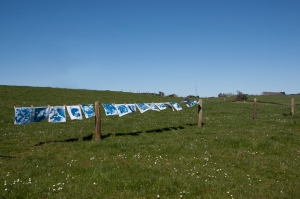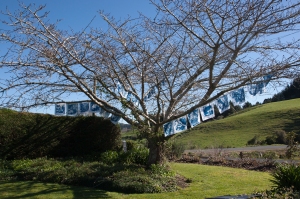While making my cyanotype images on the napkins a friend of mine suggested that they reminded him of prayer flags. Initially I recoiled and wanted nothing to do with that idea. My knowledge of prayer flags was zero and I had preconceptions that they were about praying to a god. (My reasons for the recoil was: I am not a non believer, but more of a spiritual person and have no interest in bringing religion into my work). After a few days I felt I needed to open myself up and consider my arty friends comment and do some research, this is what I found: To my surprise, I discovered the context behind these flags to actually be very spiritual and beautiful. I have learned something else again (the joy of this MFA journey is a constant opening of the mind and knowledge gaining): A prayer flag is a colorful rectangular cloth, often found strung along mountain ridges and peaks high in the Himalayas. These flags are used to bless the surrounding countryside and promote peace, compassion, strength and wisdom. (Wikipedia) The flags are not used to carry prayers to gods. “Traditionally, prayer flags come in sets of five: one in each of the five colors, which are blue, green, red, yellow & white. The five colors are arranged from left to right in a specific order: blue, white, red, green, and yellow. These five colors represent the elements and the five pure lights, being space, air, water, fire, earth. These flags are either  attached to a string or they can also be on poles, in one colour or all 5 colours. Since I am using cyanotype and that creates a blue colour on the cloth, I needed to consider if this was even a remote possibility to carry on with. But to my delight I found that, blue symbolizes the sky and space. Plants and more importantly seeds from plants travel through the sky and plants occupy space when they grow. So I felt at this stage comfortable to continue with both the research and trialling possibilities in my immediate garden space. While hanging outside, these prayer flags dance in the air while being played with by the wind & sun, as these together create magical patterns of light and shadow on the ground below. The belief is that as the wind passes over these flags, the air is purified and this clean air then carries the message that is written on the flag around the country side. And all things that are then touched by this wind will be uplifted, happier and a little wiser. “The Tibetan word for prayer flag is Dar Cho. “Dar” means to increase life, fortune, health and wealth. “Cho” means all sentient beings. Prayer flags are simple devices that, coupled with the natural energy of the wind, quietly harmonize the environment, impartially increasing happiness and good fortune among all living beings.” http://www.prayerflags.com/download/article.pdf
attached to a string or they can also be on poles, in one colour or all 5 colours. Since I am using cyanotype and that creates a blue colour on the cloth, I needed to consider if this was even a remote possibility to carry on with. But to my delight I found that, blue symbolizes the sky and space. Plants and more importantly seeds from plants travel through the sky and plants occupy space when they grow. So I felt at this stage comfortable to continue with both the research and trialling possibilities in my immediate garden space. While hanging outside, these prayer flags dance in the air while being played with by the wind & sun, as these together create magical patterns of light and shadow on the ground below. The belief is that as the wind passes over these flags, the air is purified and this clean air then carries the message that is written on the flag around the country side. And all things that are then touched by this wind will be uplifted, happier and a little wiser. “The Tibetan word for prayer flag is Dar Cho. “Dar” means to increase life, fortune, health and wealth. “Cho” means all sentient beings. Prayer flags are simple devices that, coupled with the natural energy of the wind, quietly harmonize the environment, impartially increasing happiness and good fortune among all living beings.” http://www.prayerflags.com/download/article.pdf  The images that I have transferred onto the napkins are of forgotten foods. Plants we can eat, but we have forgotten this knowledge and simply consider them mostly as weeds (A weed after all is only a plant growing in the wrong place, this can also be that grannies bonnet or the Phlomis that seeds freely) and do not give them a second glance when pulling them out of the garden. So the idea that these ‘flags’ will be gently blown about in the wind and that this wind carries this knowledge to others, is a very magical layer of this potential work. It is also believed that as these flags fade in the outdoors, this fading is a sign that the message on the flag is being ‘distributed’ by the wind. What a great thought that through such a gentle way, you can impart knowledge onto others.
The images that I have transferred onto the napkins are of forgotten foods. Plants we can eat, but we have forgotten this knowledge and simply consider them mostly as weeds (A weed after all is only a plant growing in the wrong place, this can also be that grannies bonnet or the Phlomis that seeds freely) and do not give them a second glance when pulling them out of the garden. So the idea that these ‘flags’ will be gently blown about in the wind and that this wind carries this knowledge to others, is a very magical layer of this potential work. It is also believed that as these flags fade in the outdoors, this fading is a sign that the message on the flag is being ‘distributed’ by the wind. What a great thought that through such a gentle way, you can impart knowledge onto others.
It has been my concern for a long time already, how many people do not know how to produce their own food, or look for edibles in their neighborhood, let along make a meal ‘from scratch’. The rising support for Farmers markets, Foraging groups and even artist creating gardens on waste land are welcome steps for me to be observing.
As far as what is on these traditional prayer flags (I could not have written this any better, so here is an excerpt from Wikipedia): “The center of a prayer flag traditionally features a Lung ta (powerful or strong horse) bearing three flaming jewels (specifically ratna) on its back. The Ta is a symbol of speed and the transformation of bad fortune to good fortune. The three flaming jewels symbolize the Buddha, the Dharma (Buddhist teachings), and the Sangha (Buddhist community): the three cornerstones of Tibetan philosophical tradition. Surrounding the Lung-ta are various versions of approximately 400 traditional mantras (Note: a mantra is a group of words capable of creating transformation) each dedicated to a particular deity. These writings include mantras from three of the great Buddhist Bodhisattvas: Padmasambhava (Guru Rinpoche), Avalokiteśvara (Chenrezig, the bodhisattva of compassion, and the patron of the Tibetan people), and Manjusri. In addition to mantras, prayers for a long life of good fortune are often included for the person who mounts the flags. I have a few ‘flags’ now, so my next step would be to create some knowledgeable mantras to add to these ‘flags’.
